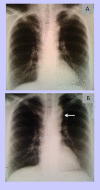Coarctation of the aorta in adults: what is the best treatment? Case report and literature review
- PMID: 21776305
- PMCID: PMC3124275
Coarctation of the aorta in adults: what is the best treatment? Case report and literature review
Abstract
Coarctation of the aorta is a congenital cardiac malformation that can go undiagnosed until old age with only hypertension as a marker of its presence because clinical signs can be subtle and overlooked if a complete physical exam is not performed. We report the case of a 45 year-old women, diagnosed with severe coarctation of the aorta just distal to the left subclavian artery, with poststenotic dilatation of the descending aorta and difficult control of blood pressure values. The patient was successfully treated interventionally, by balloon angioplasty with deployment of a covered stent. We review here the different methods employed for the treatment of coarctation of the aorta in adults, including surgical or percutaneous balloon angioplasty with or without stent placement, underlying their complications and the factors that influence the choice of the best coarctation repair method.
Keywords: aortic coarctation; balloon angioplasty; covered stent; surgery.
Figures





References
-
- Agarwala BN, Bacha E. Clinical manifestations and diagnosis of coarctation of the aorta . 2009
-
- Anagnaostopoulos–Tzifa A. Management of Aortic Coarctation in Adults: Endovascular Versus Surgical Therapy . Hellenic J Cardiol . 2007;48:290–295. - PubMed
-
- Horvath R, Towgood A. Role of Transcatheter Therapy in the Treatment of Coarctation of the Aorta . J Invasive Cardiol . 2008;20(12):660–663. - PubMed
-
- Warnes CA, Williams RG, Bashore TM, Child JS, Connolly HM, Dearani JA. ACC/AHA 2008 Guidelines for the Management of Adults with Congenital Heart Disease: a reportof the American College of Cardiology/American Heart Association Task Force on Practice Guidelines (writing committee to develop guidelines on the management of adults with congenital heart disease) . Circulation. 2008;118:714–833. - PubMed
-
- Baumgartner H, Bonhoeffer P, De Groot NM, de Haan F, Deanfield JE. Task Force on the Management of Grown-up Congenital Heart Disease of the European Society of Cardiology (ESC). Guidelines for the management of grown-up congenital heart disease. The Task Force on the Management of Grown–up Congenital Heart Disease of the European Society of Cardiology (ESC) endorsed by the European Pediatric Cardiology (AEPC) . Eur Heart J. 2010;31(23):2915–2957. - PubMed
Publication types
MeSH terms
LinkOut - more resources
Full Text Sources
Other Literature Sources
